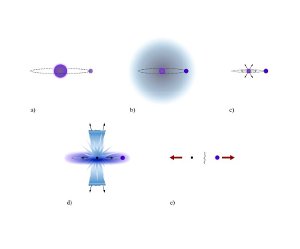 |
|
Fig. 1:
The young star, now in the Galactic halo, was ejected from the outer
rim of the Galactic disk (Heber et al., 2008, A&A, 483, L21), instead of the
Galactic Centre, as expected. The image represents the Milky Way.
Original photo in Fig. 1 courtesy of ESO.
|
 |
 |
|
Fig. 2:
Chemical abundance pattern of HD 271791 shows pollution by a
supernova/hypernova explosion (filled circles; abundance relative to
solar as a function of atomic number Z, normalized to Fe; open squares
yields of Nomoto et al., 2006, NuPhA, 777, 424).
|
 |
 |
|
Fig. 3:
Proposed binary ejection scenario.
a) Initial system: wide binary, M1 > 55 solar masses,
M2 = 11 solar masses (HD 271791)
b) Fast expansion of the primary near end of H-burning:
common-envelope phase with spiral-in of the secondary;
dissipation of the envelope.
c) Short-period binary, M1 = 20 solar masses (Wolf-Rayet WC star with
strong stellar wind), M2 = 11 solar masses
d) Asymetric hypernova/supernova explosion of primary,
formation of a black hole
e) Disruption of the system: HD 271791 is accelerated
to beyond the Galactic escape velocity.
We acknowledge Mrs. Mayr-Ihbe (MPE/MPA) for modifications of
original figures 1 and 3.
|
|  |
Using the ESO 2.2m telescope, the team has recorded a massive star
(11 times as massive as the Sun) moving at 2.2 million kilometres per hour.
The gravitational pull of the Milky Way is too small to keep the star bound
to it. Hence the star will escape into intergalactic space.
Such objects have first been discovered in 2005
and systematic surveys have identified another 16 such so-called
hyper-velocity stars in the meantime. It is general consensus that it
requires a super-massive black hole to accelerate stars to such an
extraordinary speed. As the Galactic centre is known to host such a black hole,
it is generally believed that the hyper-velocity stars come from the very
centre of the Milky Way. HD 271791, as the new hyper-velocity star is
called, is different.
It was recently shown from kinematic measurements that HD 271791 can not
originate from the Galactic centre. Quite to the opposite it comes from
the outer rim of the Galaxy where no massive black hole is known to lurk.
Hence, there must be another mechanism
that is powerful enough to eject a star into intergalactic space. The
team proceeded with a meticulous study of the data following their
methodology developed for normal young early-B stars that allow very
precise chemical abundances to be derived
 [1].
The hypervelocity
star's chemical composition show small but significant deviations from
normal. The fingerprints point to a violent death: elements that are
formed when very massive stars die in a supernova explosion are
overabundant in HD 271791 [1].
The hypervelocity
star's chemical composition show small but significant deviations from
normal. The fingerprints point to a violent death: elements that are
formed when very massive stars die in a supernova explosion are
overabundant in HD 271791  [2]. [2].
The authors investigated a scenario in which the hyper-velocity star
originally orbited an even more massive star  [2]. This primary's life
was very short and ended with a supernova explosion. The binary was
disrupted and the companion (HD 271791) released at its orbital
speed. Supernova ejecta fell onto the companion and polluted its
atmosphere with freshly produced elements. [2]. This primary's life
was very short and ended with a supernova explosion. The binary was
disrupted and the companion (HD 271791) released at its orbital
speed. Supernova ejecta fell onto the companion and polluted its
atmosphere with freshly produced elements.
Up to now such a scenario has been dismissed for hyper-velocity stars,
because the supernova precursor usually is a super-giant star and any
companion has to be at large distance in order to orbit the
star. Hence the orbital velocities are fairly modest. The most
massive stars in the Galaxy, however, end their lives as quite compact
so-called Wolf-Rayet stars rather than as super-giants. The
compactness of the primary leaves room for a companion to move rapidly
on a close orbit of about 1 day-period. When the Wolf-Rayet-star
exploded its companion HD 271791 was released at very high speed. In
addition, HD 271791 made use of the Milky Way rotation to finally
achieve escape velocity.
Hence HD 271791 is witness for the death of a very massive star (more
than 55 times that of the Sun) that collapsed about 20 million years
ago into a black hole. This may have been a truly spectacular event,
as the collapse of a Wolf-Rayet star is not necessarily accompanied by
an ordinary supernova explosion - it is also suggested as the origin
of the most violent explosion in the universe, a Gamma-ray burst.
Maria Fernanda Nieva
Publications
[1] Maria Fernanda Nieva,
"Quantitative Spectroscopy of OB stars.",
2007, cotutelle PhD thesis at University of Erlangen-Nuremberg (Germany) and Observatorio Nacional (Brazil),
Verkannten Verlag (Berlin), ISBN: 978-3-00-023064-6
[2] Norbert Przybilla, Maria Fernanda Nieva, Ulrich Heber and Keith Butler,
"HD 271791: An Extreme Supernova Runaway B Star Escaping from the Galaxy",
2008, Astrophysical Journal Letters, 684, L103
|




